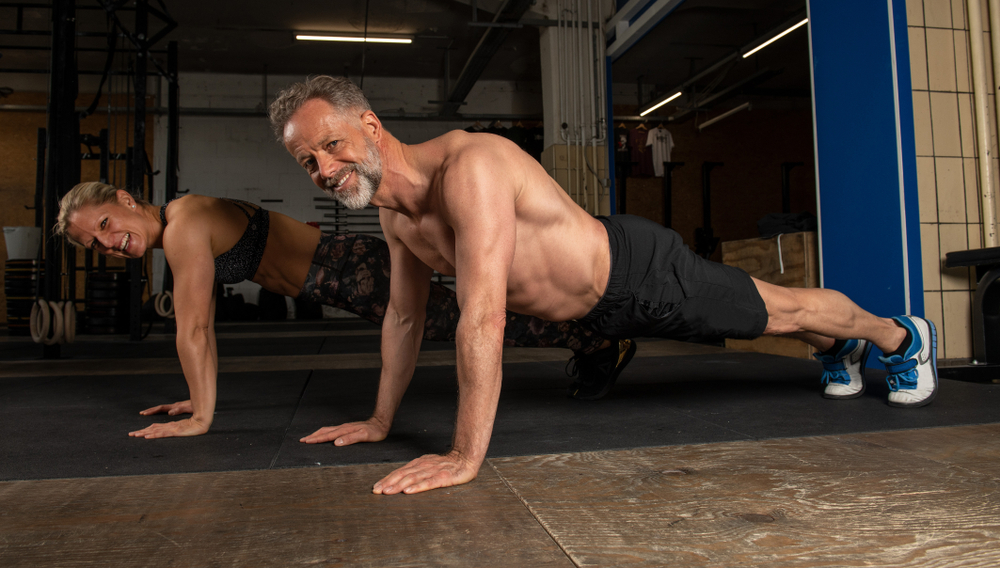The T-push-up is a dynamic bodyweight exercise that combines a traditional push-up with a side plank, targeting your chest, shoulders, triceps, core, and glutes all at once.
It builds strength, stability, and coordination in one fluid motion—keep reading for a full breakdown of how it works, how to do it right, and how to fit it into your training.
Muscles Worked: A Multi-Joint, Multi-Muscle Movement
T-push-ups engage a wide range of muscles at once, making them a powerful addition to any strength or conditioning routine.
Because the movement involves both a push-up and a rotation into a side plank, your body works across multiple planes, recruiting stabilizers and movers in unison.
This full-body activation is what gives the T-push-up its reputation for building strength and control at the same time.
Chest: Generating Power in the Push
The chest, specifically the pectoralis major, is heavily engaged during the pressing portion of the movement.
As you lower and push yourself back up, your chest muscles generate most of the force.
While this part looks identical to a regular push-up, what makes it more demanding is the added instability introduced by the upcoming rotation.
If your form is tight—hands under shoulders, elbows tracking at about a 45-degree angle—you'll notice your chest doing a lot of the work without straining the shoulders.
Shoulders: Stabilizing and Supporting the Turn
Your shoulders play two roles in this exercise.
First, the deltoids stabilize the shoulder joint throughout the push-up, keeping your upper body steady and aligned.
Then, during the transition to the side plank, your lead shoulder bears most of your bodyweight as it shifts into a support role.
Meanwhile, the opposite deltoid activates to lift your arm overhead, making this a double-duty task for shoulder strength and endurance.
If you're feeling wobbly in the turn, it's usually a shoulder control issue—not just a core one.
Triceps: Driving the Elbow Extension
Though not the main mover, your triceps are key assistants in the push-up phase.
They help extend your elbows as you press back up from the ground.
Weak or underdeveloped triceps can limit your ability to maintain form through multiple reps, especially when fatigue sets in.
If you're finding it hard to lock out your arms or stay smooth during the push, it might be time to strengthen this area separately with triceps dips or close-grip push-ups.
Core: Rotational Control and Stabilization
Your core does more than just brace—it moves.
During the rotational part of the T-push-up, deep stabilizers like the obliques and transverse abdominis fire up to help you pivot without twisting out of alignment.
The erector spinae also chip in to maintain spinal integrity while you shift.
If your rotation feels choppy or your hips drop unevenly, it's a sign your core isn't fully in control.
Slowing down and practicing the movement with strict form can help improve that activation over time.
Glutes: Anchoring the Hips Through Movement
Surprisingly to some, your glutes play a meaningful role in this movement.
As you rotate into the side plank, your hips need to stay level and supported—this is where the glutes come in.
They contract to stabilize your pelvis, preventing sagging or over-rotation.
If you struggle with hip alignment or feel your lower back straining, it's likely you're underusing the glutes.
A brief squeeze at the top of each rotation can help lock them in and build awareness.
Full-Body Benefits of T-Push-Ups
T-push-ups aren’t just about getting stronger—they help you move better.
Because they challenge your body across multiple planes of motion, they develop strength, control, and coordination in ways that traditional exercises often overlook.
Here’s a closer look at the unique benefits this movement brings to your training.
Core Stability: More Than Just Abs
The rotational movement in a T-push-up brings your core muscles front and center—especially the ones you don’t always feel in traditional ab work.
It’s not just about bracing; your obliques, transverse abdominis, and spinal stabilizers actively control the twist and keep your torso aligned as you shift into the side plank.
This kind of control builds real-world core strength—the kind that helps you stay stable when you twist, reach, or change direction in sports or daily life.
If you’re aiming to prevent injury or improve posture, this deep core engagement is where a lot of that value lives.
Upper Body Strength: A Smarter Combination
Since the T-push-up blends a standard push-up with a side plank, you’re essentially training your chest, shoulders, and arms in one continuous motion.
The pressing phase develops pushing strength, while the hold at the top works shoulder stability and endurance—especially in the deltoids and triceps.
Over time, this builds a more resilient upper body that can push, stabilize, and support load under shifting conditions.
It's particularly useful for anyone who wants to get more functional strength out of fewer exercises without compromising on intensity.
How to Perform a T-Push-Up: Step-by-Step Technique

Getting the most out of a T-push-up depends on proper form from start to finish.
Since this movement combines both strength and balance, small details—like where your hands are or how you breathe—can make a big difference in performance and safety.
Here’s how to break it down and build it up the right way.
Set-Up: Start with a Solid Base
Begin in a high plank position with your hands directly under your shoulders and your feet set about hip-width apart.
This spacing provides just enough stability for the upcoming rotation without limiting your range of motion.
Make sure your body forms a straight line from head to heels.
Your spine should stay neutral—no arching at the lower back or rounding through the shoulders.
Keep your neck in line with your spine by looking slightly ahead of your fingertips, not down at your feet.
Before you move, engage your core and glutes lightly to lock your position in place.
Execution: Control the Push-Up
Lower your chest by bending at the elbows, keeping them angled back at roughly 45 degrees—not flared out to the sides.
This protects the shoulders and shifts more load to the chest and triceps.
Move with control on the way down; speed often leads to form breakdown.
Your chest should come just above the floor (or touch it, depending on your strength and mobility), then press back up in one strong line.
Avoid letting your hips sag or pike—your torso should rise and fall as a unit.
Rotation Mechanics: Move Smoothly Into the “T”
At the top of the push-up, shift your weight onto one hand and begin rotating your torso to open up to the side.
Your feet will need to pivot—stacking one foot over the other—as your body turns.
Extend the free arm straight toward the ceiling, forming a “T” shape with your body.
Your hips should stay lifted and square, aligned with your shoulders.
Pause briefly in this position to reinforce balance and alignment, then rotate back to the plank before repeating on the other side.
If you lose balance during the transition, slow the movement down and focus on keeping your core engaged throughout.
Key Cues for Form and Breath Control
Think of pulling your belly button toward your spine as you rotate—that core engagement is what keeps your form tight and reduces wobble.
During the push-up, inhale as you lower and exhale as you press up; keep the exhale going as you rotate into the side plank.
This helps stabilize your core and maintain control.
Focus your eyes on your top hand during the rotation—it can help with balance and improve shoulder alignment.
Lastly, aim to move fluidly, not in jerky steps; the more connected the phases are, the more benefit you’ll get out of each rep.
Functional Movement Pattern: Real-World Application
What makes the T-push-up more than just a creative push-up variation is its functionality.
It mimics the kind of rotational movements we use in everyday life—reaching for something, turning to look behind, reacting to uneven terrain.
These types of compound, multi-plane movements improve your body's ability to handle unexpected changes in direction or posture.
That means more fluid movement patterns and better overall mobility, which becomes especially important in sports or active jobs where control and responsiveness matter.
Coordination and Balance: Training the Invisible Skills
Transitions between the push-up and the side plank demand precision.
You need to shift your weight smoothly, rotate without wobbling, and raise your arm in sync with your torso.
This sequence sharpens your proprioception—your sense of body position—and enhances neuromuscular control.
These are the hidden skills behind athletic performance, and they also make everyday tasks feel easier and more stable.
If you feel shaky or off-balance when rotating, that’s your nervous system learning how to connect the dots.
Practicing T-push-ups regularly helps strengthen those connections and sharpens your overall movement quality.
Programming T-Push-Ups for Your Training Goals
T-push-ups can be adapted to fit nearly any training goal—you just have to adjust how you use them.
Whether you're aiming for strength, muscle growth, endurance, or power, the key is knowing how many reps to do, how much rest to take, and where to place them in your workout.
Here's how to tailor the T-push-up to match your specific needs.
Strength: Low Reps, High Control
If your focus is building strength, aim for 3 to 5 sets of 3 to 5 reps per side.
You can increase difficulty by adding light weights—holding dumbbells during the push-up and rotation is one option.
Just make sure form stays sharp; heavy loading without control defeats the purpose.
Rest 1.5 to 3 minutes between sets, and place the T-push-up early in your workout, after your main compound lifts or as part of your core-focused strength work.
Hypertrophy: Moderate Reps, Consistent Tension
For muscle growth, volume matters. Perform 3 to 4 sets of 8 to 12 reps per side with good form and steady tempo.
The goal is to keep the muscles under tension long enough to stimulate growth, so avoid rushing through the reps.
Bodyweight is often enough, but you can add resistance bands or slow down the descent phase to boost difficulty.
These sets work well mid-workout, paired with other push or core-focused movements.
Endurance: High Reps, Sustained Output
To build muscular endurance, go for 12 to 20 reps per set, keeping your movement smooth and consistent.
You may want to drop to your knees for the push-up phase, especially in later sets.
This helps you maintain control without sacrificing quality.
Use these higher-rep sets as part of a conditioning circuit or a bodyweight finisher at the end of your workout.
Rest periods should be shorter—30 to 60 seconds between sets to keep the challenge going.
Power Training: Fast, Explosive Reps
Power-focused T-push-ups are all about intent.
That means doing 1 to 3 explosive reps per set—think fast push-up, fast rotation—with long rest intervals of 2 to 3 minutes.
You’re not just moving fast for the sake of it; you’re training your muscles and nervous system to generate force quickly.
These are best done early in your session, when your body is fresh and ready to produce speed and power.
When to Use Them in Your Workout
- Warm-Up: Use lighter reps or knee variations to activate core and shoulder stabilizers without fatigue.
- Main Set: Slot them in as a primary bodyweight movement or pair with strength-based push or pull exercises.
- Finisher: Go for higher reps or continuous reps for time to end your workout with a burn.
Variations and Modifications for Every Fitness Level
T-push-ups can be scaled up or down depending on your fitness level, which makes them accessible whether you’re just starting out or looking to add complexity to your training.
Each variation targets the same muscle groups but shifts the challenge slightly—either by reducing the load or increasing balance and coordination demands.
Below are a few effective options and how to integrate them based on your needs.
Knee T-Push-Up: Lower the Load, Keep the Pattern
The knee variation is a great place to start if you're still developing upper body or core strength.
Instead of starting in a full plank, you’ll begin with your knees on the ground while keeping your upper body mechanics the same.
This reduces the total bodyweight you need to push, making it easier to focus on form and coordination.
The key is to keep your hips forward so your torso still moves as one unit.
Don’t rush through the rotation—move slowly to build body awareness and control.
Weighted T-Push-Up: Add Load Safely
If standard T-push-ups feel solid and you want to push further, adding resistance is the next logical step.
Light dumbbells work best here—nothing too heavy, as it’s easy to lose control during the rotation.
You can hold the dumbbells throughout the movement, or perform the push-up on dumbbell handles and lift one off the ground during the side plank.
Stability becomes a bigger factor when weight is involved, so make sure your core stays tight and your shoulders don’t collapse under load.
Keep reps low at first and focus on quality.
Single-Leg T-Push-Up: Challenge Coordination and Core
Lifting one leg during the rotation takes the movement to another level.
This version increases instability and forces your core and glutes to work overtime to keep everything aligned.
As you push up and rotate, lift the leg opposite the supporting arm.
For example, if you’re rotating to the left and raising your right arm, lift your right leg as well.
The key is subtle control, not height—aim to keep your lifted leg in line with your torso.
This is an advanced variation, so master the regular version first before progressing here.
Scaling Up or Down: Smart Progression Strategies
Start with the basics—perfect your form with the standard version or drop to the knees if needed.
Once you can maintain alignment and control through a full set, begin layering in difficulty.
You might add reps, slow down the tempo, or move to a single-leg variation.
If form starts to slip or rotation feels unstable, regress slightly by shortening the range of motion or going back to a more stable version.
The goal is to train with precision, not just push through reps.
Common Mistakes and How to Avoid Them
Even though the T-push-up looks straightforward, it’s easy to let small mistakes slip in—especially when you're focused on balancing or getting through reps.
These errors can reduce the effectiveness of the exercise and, over time, lead to strain or injury.
Knowing what to watch for (and how to fix it) will help you get more out of every rep.
Over-Rotating the Torso or Losing Core Tension
One of the most common issues during the rotation is turning too far or letting the core disengage.
When you over-rotate, your spine twists past its natural range, which can stress your lower back and throw off your balance.
Instead, focus on rotating only until your shoulders stack vertically.
Keep your abs engaged throughout the movement—imagine pulling your ribs and hips slightly together.
This internal tension is what keeps your torso stable while your arms and feet move.
Letting the Hips Sag or Twist Out of Alignment
If your hips drop or twist unevenly, it’s often a sign that your glutes or core aren’t fully engaged.
This not only reduces the effectiveness of the movement, especially on the stabilizers, but also increases stress on the lower back.
Try to maintain a straight line from your head through your hips and down to your heels.
During the rotation, your hips should stay in line with your shoulders, not dipping or twisting off-center.
Think about keeping your pelvis “quiet”—it moves with the rest of your body, not independently.
Relying Too Much on Momentum Rather Than Muscle Control
It’s tempting to speed through the movement, especially when fatigue kicks in—but using momentum instead of strength shortchanges the exercise.
You’ll miss out on muscle activation and increase your risk of sloppy form.
To fix this, slow the entire movement down, especially the rotation.
Pause briefly at the top of each side plank and focus on feeling which muscles are working.
The smoother and more deliberate each phase feels, the better the muscle recruitment.
Correcting Poor Shoulder Position or Hand Placement
Improper hand placement—too wide, too far forward, or too close together—can strain your wrists and shoulders.
Make sure your hands are directly under your shoulders during the push-up phase.
Keep your shoulder blades active, not collapsed, especially when you're in the side plank.
Your top arm should reach straight up with your chest open, not leaning backward or rotating unevenly.
If your wrists feel strained, consider performing the movement on dumbbell handles or parallettes to keep your wrists more neutral.
Conclusion
T-push-ups combine strength, stability, and coordination in one efficient movement.
When performed with control and proper technique, they target multiple muscle groups and improve overall functional fitness.
Start where you are, focus on form, and progress thoughtfully to get the most from this versatile exercise.







